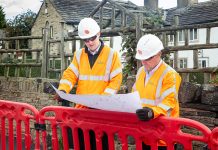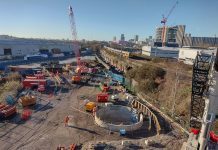with Pipeline Industries Guild (PIG) and Institute of Mechanical Engineers (IMechE)
On 28 January a joint event was held with PIG and IMechE at the new Veolia Water premises within Hatfield, Hertfordshire. This was the first Institute of Water event to be held at this location which has a very interesting history. The Hatfield Business Park is constructed on the site previously occupied by British Aerospace and its preceding companies. The first commercial jet airliner, the de Havilland Comet, was constructed here. The airfield runway and most of the original buildings have been replaced with new commercial properties and domestic housing. However, a few Art Deco style buildings have become listed and converted into new uses. Veolia Water’s neighbour was previously a huge aircraft hanger and runway control tower. This is now a hotel and fitness centre.
During the course of the evening the respective Institute Chair’s provided a brief introduction to their Institute and previewed upcoming events. This was a keynote address to introduce the new area theme for the year –‘The Customer Experience – Listen, Learn, Develop, Achieve’, and the new area events calendar was launched. All events will focus on this theme, including a comprehensive Winter Seminar planned for November. Jeff Bishop, Operations Director for Veolia Water and the Eastern Area President, introduced his theme and explained that implementing the Customer Experience agenda is providing real tangible improvements for the Veolia Water customers and employees. The Institute of Water provides a fantastic way to listen and learn from others experiences to enable one-self to develop and achieve more.
The first presentation was provided by Veolia Water’s Jo-Ann Lyon (Contact Centre Manager) and Kathryn Betts (Director’s Office Improvement Manager). Veolia Water is aiming to become the best utility in the community by 2011. One of the goals is to reduce the need for customers to contact the company due to a problem occurring. Research into the reasons why customers contact the company with complaints has identified the most common problems. Veolia Water is implementing changes to prevent these problems occurring in the first place. Veolia Water is also improving the process for the occasions when customers do have to contact the company. All the typical reasons why a customer contacts the company are being examined and improved to provide a quick seamless experience for the customer. Other methods include increasing the information available on the company internet site to enable customers to locate information quickly themselves and obtain their billing information, or to provide meter readings etc.
All parts of Veolia Water are implementing a review process called ‘Gone Well? Not Gone Well?’ This provides an opportunity to examine problems with current processes, but also to celebrate successful events and enable good practice to be shared. James Hale (Technical Delivery Manager for Wastewater) from Mouchel started the next presentation with several dramatic examples of flooding. Mouchel are working hard to implement methods to reduce the impact of these events. In addition to the objective to improve the experience of the customers in risk areas, James briefed out The Pitt Review and the Flood and Water Management Bill.
Flood warning equipment has been installed for many years to provide prior warning of possible river flooding. However it has traditionally been more difficult to predict flooding from the waste and surface water pipe networks. Mouchel are implementing STUFF to provide prior warning of impending flooding from these pipe networks – Short Term Urban Flood Forecasting. The process starts with weather forecasting using Met Office information and radar rain detection. Computer simulation models are utilised to predict the effect of this weather on the drainage networks. Potential flood situations can then be predicted. The first action is to mobilise operatives to the precise risk areas to ensure the equipment, such as pumps and screens are operating as efficiently as possible, which may prevent flooding occurring.
In extreme conditions flood prevention may not be possible. The computer models will identify the properties at risk of being flooded. Prior warning can be provided to the occupants to enable them to take action to protect the property, using methods such as installing sandbags and sealing low level air vents. The Local Authority can plan and implement measures such as diverting traffic from affected routes and relocate people to safe locations. This early warning system has the potential to save many properties from damage and keep people safe.





